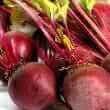Background
- Beet is a flowering perennial plant that produces leaves and roots that are widely used as a food source in humans and animals. Beets are a source of vitamins A and C, iron, and other minerals, carotenoids, and dietary fiber.
- Betalins are natural pigments (colors) in beets that account for the red color in beet stems and leaves. After eating beets, these pigments produce red or pink urine (called beeturia) in about 10%-14% of people.
- Sugar has been extracted from beets and used as a sweetener since the 16th Century and is still widely used today.
- Beet pulp, the remaining byproduct of beet juices and sugars extracted from the root, is widely used in animal feed as a source of dietary fiber in humans. It is also used as a biosorption matrix.
- According to secondary sources, beetroot has been used since Roman times to treat various medical conditions, including fever, constipation, digestive illnesses, and blood conditions. In ancient Rome, it was also used as an aphrodisiac. Today, beetroot is still a popular medicinal tonic in Africa, where it is used in treatment of AIDS and other illnesses. Beet leaves also have a long history of use for medicinal purposes; it is alleged that Hippocrates promoted use of the leaves for treatment of wounds.
- Human studies have tested the effects of beet on blood sugar, cholesterol and blood pressure levels. However, results are mixed. Early evidence suggests that it may be beneficial for inflammation of the abdomen and pelvic walls (called toxic peritonitis). Additional research is needed to determine if beet is effective for any medical condition.
- The U.S. Food and Drug Administration (FDA) has approved dehydrated beets and sugar beet extract flavor base as food additives or listed or affirmed them as generally regarded as safe (GRAS).
- The American Academy of Pediatrics recommends avoiding feeding beets and other high-nitrate foods to infants younger than three months of age to avoid the risk of nitrate poisoning.
References
Natural Standard developed the above evidence-based information based on a thorough systematic review of the available scientific articles. For comprehensive information about alternative and complementary therapies on the professional level, go to . Selected references are listed below.
- Briskin, BS and Demidov, DA. [Enterosorption with pectin-containing medication in the treatment of peritonitis]. Khirurgiia (Mosk) 2005;(4):14-19.
View Abstract - Castor, ML, Wagstrom, EA, Danila, RN, et al. An outbreak of Pontiac fever with respiratory distress among workers performing high-pressure cleaning at a sugar-beet processing plant. J Infect Dis 5-1-2005;191(9):1530-1537.
View Abstract - Cossack, ZT and Musaiger, AO. Effect on lipid metabolism of beet fibre in desert nomads with low habitual fibre intake. Eur J Clin Nutr 1991;45(2):105-110.
View Abstract - Hagander, B, Asp, NG, Efendic, S, et al. Reduced glycemic response to beet-fibre meal in non-insulin-dependent diabetics and its relation to plasma levels of pancreatic and gastrointestinal hormones. Diabetes Res 1986;3(2):91-96.
View Abstract - Hagander, B, Asp, NG, Ekman, R, et al. Dietary fibre enrichment, blood pressure, lipoprotein profile and gut hormones in NIDDM patients. Eur J Clin Nutr 1989;43(1):35-44.
View Abstract - Hamberg, O, Rumessen, JJ, and Gudmand-Hoyer, E. Blood glucose response to pea fiber: comparisons with sugar beet fiber and wheat bran. Am J Clin Nutr 1989;50(2):324-328.
View Abstract - Harel, P, Mignot, L, and Junter, GA. Sugar beet Ca-pectate gel as a cost-effective immobilized-cell matrix for metal biosorption. Meded Rijksuniv Gent Fak Landbouwkd Toegep Biol Wet 2001;66(3a):291-294.
View Abstract - Lampe, JW, Slavin, JL, Baglien, KS, et al. Serum lipid and fecal bile acid changes with cereal, vegetable, and sugar-beet fiber feeding. Am J Clin Nutr 1991;53(5):1235-1241.
View Abstract - Patel, MR, Baer, RJ, and Acharya, MR. Increasing the protein content of ice cream. J Dairy Sci 2006;89(5):1400-1406.
View Abstract - Schwab, U, Louheranta, A, Torronen, A, et al. Impact of sugar beet pectin and polydextrose on fasting and postprandial glycemia and fasting concentrations of serum total and lipoprotein lipids in middle-aged subjects with abnormal glucose metabolism. Eur J Clin Nutr 2006;60(9):1073-1080.
View Abstract - Stevens, J, Ahn, K, Juhaeri, Houston, D, et al. Dietary fiber intake and glycemic index and incidence of diabetes in African-American and white adults: the ARIC study. Diabetes Care 2002;25(10):1715-1721.
View Abstract - Zenaidi, M, Pauliat, S, Chaliier, P, et al. [Allergy to food colouring. A prospective study in ten children]. Tunis Med 2005;83(7):414-418.
View Abstract - Stevens, J, Ahn, K, Juhaeri, et al. Dietary fiber intake and glycemic index and incidence of diabetes in African-American and white adults: the ARIC study. Diabetes Care 2002;25(10):1715-1721.
View Abstract - Tamme, T, Reinik, M, Roasto, M, et al. Nitrates and nitrites in vegetables and vegetable-based products and their intakes by the Estonian population. Food Addit Contam 2006;23(4):355-361.
View Abstract - Thorsdottir, I, Andersson, H, and Einarsson, S. Sugar beet fiber in formula diet reduces postprandial blood glucose, serum insulin and serum hydroxyproline. Eur J Clin Nutr 1998;52(2):155-156.
View Abstract







